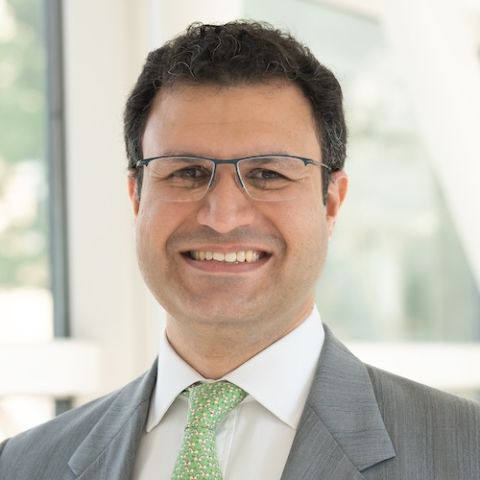When it comes to the risk of developing breast cancer, the use of synthetic estrogen by women experiencing menopause — especially for women who have already been treated for the disease — has been controversial for many years.
In an effort to dispel myths and provide risk-versus-benefit guidance, gynecologic oncologist Nicole Gaulin, MD, and Sheheryar Kabraji, BMBCh, Chief of Breast Medicine, both of Roswell Park Comprehensive Cancer Center, address some of the common concerns and questions.
What is hormone replacement therapy?
Dr. Gaulin explains that hormone replacement therapy such as synthetic estrogen and/or progesterone replaces the naturally-made estrogen and/or progesterone in women assigned female at birth as a way to make up for the lack of these hormones produced by the ovaries, such as occurs with menopause.
But insufficient natural production of estrogen and progesterone is only one scenario in which someone might be prescribed hormone replacement therapy, she says. It might also be prescribed for women who enter surgical menopause due to cancer treatment, or for those diagnosed with ovarian cancer. Some women whose ovaries have been damaged by chemotherapy or radiation also might be prescribed hormone replacement therapy.
“Ovarian insufficiency is a debilitating condition. These women suffer increased risk of cardiac death, all-cause mortality, fractures, osteoporosis and, among the side effects of lack of estrogen in the vagina leading to what we call genitourinary symptoms of menopause, including vaginal dryness, dyspareunia or pain with intercourse, urinary tract infections and other conditions,” she says.
Why do some people think replacement therapy is dangerous?
In the mid-1990s, the Women’s Health Initiative suggested some “potential adverse outcomes” associated with women who used hormone replacement therapy, but women with primary ovarian insufficiency were not included in that trial. The study did not address the risks faced by younger women who begin menopause in their 40s or earlier.
“Now, we have excellent data to support the use of hormone replacement therapy in these women. The risk of vertebral fractures and hip fractures is significantly decreased with the use of hormone therapy,” Dr. Gaulin says.
“Women facing early menopause have a nearly 50% increased risk of ischemic-related cardiac morbidity, something that can be significantly decreased with the use of hormone therapy.”
Get a second opinion with Roswell Park experts
Whether you've just been diagnosed, exploring treatment, or you're looking for survivorship services, you can always talk to our experts about all of your options.
What options are available for symptom management?
Oral contraceptives have a higher dose of estrogen and progesterone compared to the types of hormone replacement treatments available, she adds, but they can still be an option if needed. Other treatment options include patches as well as oral medications.
Intravaginal estrogen is safe, which Dr. Gaulin describes as an “incredible tool” that is highly effective for treating vaginal side effects of menopause, including vaginal dryness, pain during intercourse, recurring urinary tract infections and other conditions.
As a breast oncologist, Dr. Kabraji sees a need to eliminate or reduce the production of estrogen to help a patient fight their cancer. However, options for doing this, he says, “lead to exactly the same kind of side effects, where women will have both the new side effects of deprivation, such as hot flashes and joint pains, but then also genitourinary and other side effects,” he says.
“For patients being treated for breast cancer, in the curative setting, the data are a bit mixed depending on whether medications including tamoxifen versus an aromatase inhibitor are used and for the relative risk of subsequent breast cancer events when using estrogen therapy. But in general, the chance of having an increased risk of developing breast cancer is small,” Dr. Kabraji says. “We do encourage, at least in our practice, a conversation about using topical estrogens between the patient and their doctor, because the benefits can be significant, especially when it comes to those complications.”
What about women who have entered menopause naturally?
Dr. Kabraji also advises that much of the data driving physicians’ advice on this topic is quite old. “Some of it involves preparations and types of estrogens at higher doses with more exposure than we would typically recommend today,” he notes. At least in part, the information is based on a 1990s Women’s Health Initiative study that was suspended due to concerns of an increased risk of breast cancer among women who were on estrogen therapy and had an intact uterus.
“The use of hormone replacement therapy in the menopausal setting is a bit more nuanced,” Dr. Gaulin explains. Recommendations for this treatment are usually reserved for women under the age of 60 and are more favorable, with better outcomes, than for women who are older.
This is why women should always talk over their options with their doctor — whether they are going through cancer treatment or facing primary ovarian failure or after menopause — before making any decisions regarding hormone replacement therapy.
“It’s critical to think about that risk-benefit analysis, the root of the need for estrogen replacement, and what those benefits might be,” Dr. Kabraji says.





